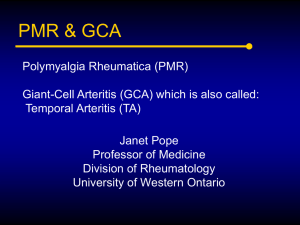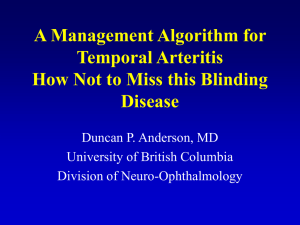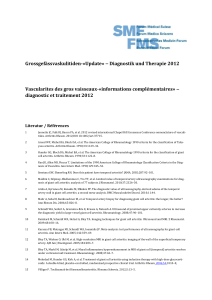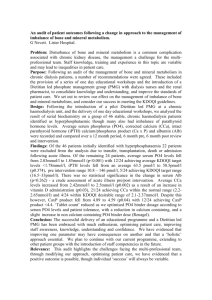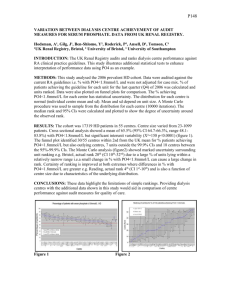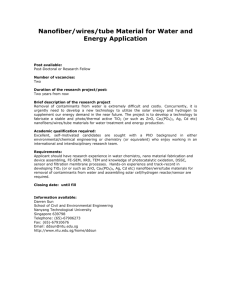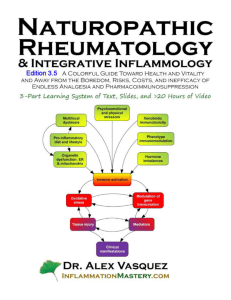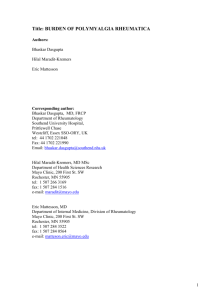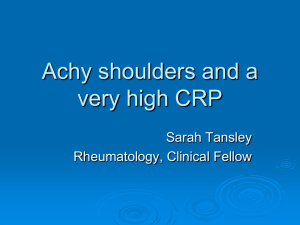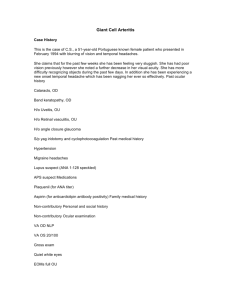Susan Merel
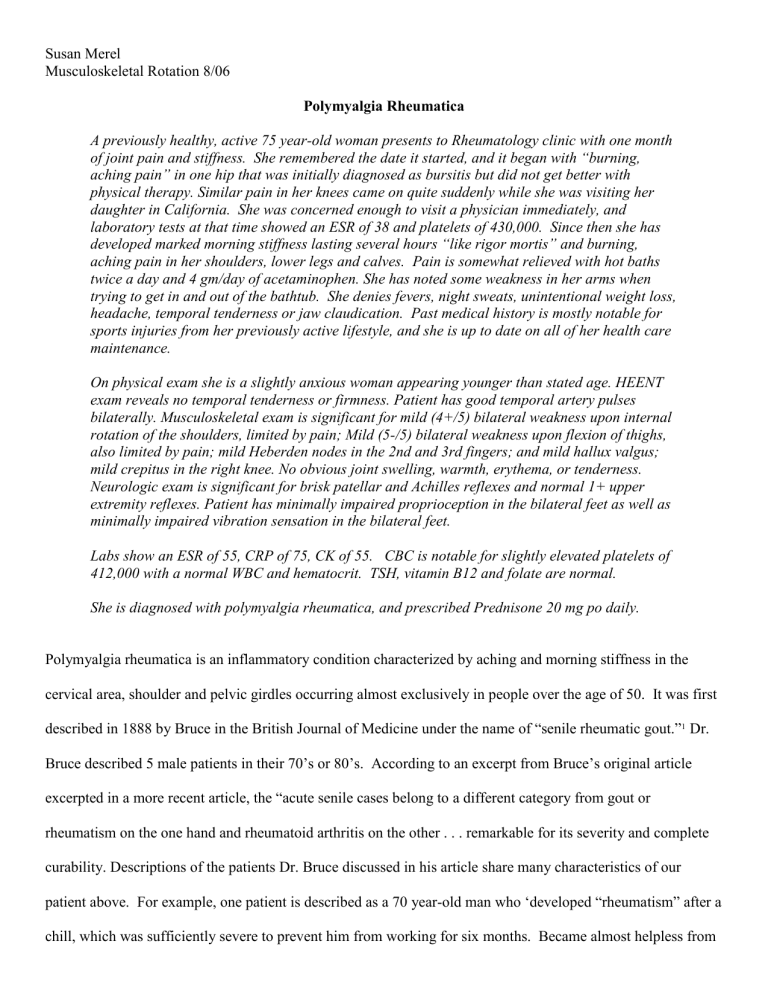
Susan Merel
Musculoskeletal Rotation 8/06
Polymyalgia Rheumatica
A previously healthy, active 75 year-old woman presents to Rheumatology clinic with one month of joint pain and stiffness. She remembered the date it started, and it began with “burning, aching pain” in one hip that was initially diagnosed as bursitis but did not get better with physical therapy. Similar pain in her knees came on quite suddenly while she was visiting her daughter in California. She was concerned enough to visit a physician immediately, and laboratory tests at that time showed an ESR of 38 and platelets of 430,000. Since then she has developed marked morning stiffness lasting several hours “like rigor mortis” and burning, aching pain in her shoulders, lower legs and calves. Pain is somewhat relieved with hot baths twice a day and 4 gm/day of acetaminophen. She has noted some weakness in her arms when trying to get in and out of the bathtub. She denies fevers, night sweats, unintentional weight loss, headache, temporal tenderness or jaw claudication. Past medical history is mostly notable for sports injuries from her previously active lifestyle, and she is up to date on all of her health care maintenance.
On physical exam she is a slightly anxious woman appearing younger than stated age. HEENT exam reveals no temporal tenderness or firmness. Patient has good temporal artery pulses bilaterally. Musculoskeletal exam is significant for mild (4+/5) bilateral weakness upon internal rotation of the shoulders, limited by pain; Mild (5-/5) bilateral weakness upon flexion of thighs, also limited by pain; mild Heberden nodes in the 2nd and 3rd fingers; and mild hallux valgus; mild crepitus in the right knee. No obvious joint swelling, warmth, erythema, or tenderness.
Neurologic exam is significant for brisk patellar and Achilles reflexes and normal 1+ upper extremity reflexes. Patient has minimally impaired proprioception in the bilateral feet as well as minimally impaired vibration sensation in the bilateral feet.
Labs show an ESR of 55, CRP of 75, CK of 55. CBC is notable for slightly elevated platelets of
412,000 with a normal WBC and hematocrit. TSH, vitamin B12 and folate are normal.
She is diagnosed with polymyalgia rheumatica, and prescribed Prednisone 20 mg po daily.
Polymyalgia rheumatica is an inflammatory condition characterized by aching and morning stiffness in the cervical area, shoulder and pelvic girdles occurring almost exclusively in people over the age of 50. It was first described in 1888 by Bruce in the British Journal of Medicine under the name of “senile rheumatic gout.” 1 Dr.
Bruce described 5 male patients in their 70’s or 80’s. According to an excerpt from Bruce’s original article excerpted in a more recent article, the “acute senile cases belong to a different category from gout or rheumatism on the one hand and rheumatoid arthritis on the other . . . remarkable for its severity and complete curability. Descriptions of the patients Dr. Bruce discussed in his article share many characteristics of our patient above. For example, one patient is described as a 70 year-old man who ‘developed “rheumatism” after a chill, which was sufficiently severe to prevent him from working for six months. Became almost helpless from
pain and stiffness in his joints. General health extremely poor and very depressed. Recovered completely after two years.’
2
The term “polymyalgia rheumatica” was proposed by Barber in 1957.
Epidemiologically, PMR is fairly common in the predominantly North American and European populations in which it has been studied, with a prevalence of 1 case per 133 people over 50 years of age. It is thought to be more common at higher latitudes. Incidence increases over age 50 and peaks between 70 and 80. It affects more women than men, with a female to male ratio of about 2.
3,4 Diagnostic criteria for PMR have been described by Healy among others and include age >50; pain persisting for > one month in two of the following areas: neck, shoulders and pelvic girdle; morning stiffness exceeding one hour; ESR >40; rapid response to <=
20 mg/day of prednisone and absence of other diseases capable of causing the symptoms.
4 Pain can also be in the trunk and lower back and typically is symmetric with an abrupt onset, often in the shoulders. Nightime pain is common, and pain often worsens with movement. Weight loss, anorexia, malaise and depression are common.
Classically, patients complain of trouble using their arms for common tasks like combing their hair or reaching for an object in a cupboard. Chills and fever are not common and should increase concern for associated temporal arteritis.
5 As in our patient, onset of PMR is often abrupt and symptoms can initially be unilateral.
The characteristic proximal pain and stiffness of the hips and shoulders is not always present at onset. In a prospective study of 287 patients with PMR and temporal arteritis in one county on the coast of South Norway
(Myklebust et al 1996), shoulder pain and stiffness was the most frequent complaint; it was reported by 78% at presentation, but only present in 21% at the onset of the disease. 6
On physical exam, patients often have limitation of active and/or passive movement of the shoulders. Joint swelling and synovitis are not classic, but are often found. Mykelbust et al found clinically detectable inflammation of the peripheral joints in 24% of the patients presenting with PMR, mostly in the knees or wrists.
7 Other clinical findings can include carpal tunnel syndrome, swelling and pitting edema of the dorsum of
the hands, wrists, ankles and tops of the feet.
Laboratory evaluation should include ESR, CBC, CRP as well as any labs necessary to help rule out alternative diagnoses. Classically ESR is above 40 in PMR, but studies have reported 7 to 20% of patients diagnosed with PMR to have a normal ESR on diagnosis. CRP has been found to be a more sensitive indicator than ESR.
8
Differential diagnosis in PMR includes seronegative rheumatoid arthritis, other vasculitides, mechanical shoulder pain, hypothyroidism, inflammatory myopathies, multiple myeloma and Parkinson’s disease. While classic presentations of PMR and RA are quite different, elderly people can present with seronegative RA associated with a benign symmetric synovitis. Both diseases will respond to steroids, making diagnosis more difficult. Polymyositis can present with proximal symmetric muscle weakness, but pain is usually not prominent. Of note, multiple myeloma can present with bone pain and an elevated ESR; SPEP and UPEP will make the distinction.
9
A viral cause is suspected based on the sudden onset of inflammation and malaise in PMR. Possible causative viruses include parainfluenza type 1, Mycoplasma pneumoniae, Chlamydia pneumoniae, and parvovirus B19.
The pathogenesis of isolated PMR is less clearly described than that of other diseases in the giant cell arteritis spectrum, but is thought to occur in the circulating blood and to involve activated monocytes which produce IL-
1 and IL-6. IL-2 mRNA is also upregulated in patients with isolated PMR.
10 The lesion that is caused is thought to be a synovitis in proximal joints and periarticular structures. Histologically, the synovitis is fairly mild and consists mainly of macrophages and CD4+ helper T cells. MRI studies suggest that this process leads to inflammation of extraarticular synovial structures; shoulder MRI shows subacromial and subdeltoid bursitis in almost all patients with shoulder symptoms.
11 Temporal artery biopsies from patients with isolated PMR do not show microscopic evidence of arteritis.
12
PMR is closely related to giant cell arteritis (also called temporal arteritis), a rarer and potentially more serious disease presenting with temporal headache and sometimes causing blindness. The diseases affect the same
population, cause similar laboratory abnormalities, and show the same disease-risk genes.
13 In fact, some have questioned whether they should actually be considered separate diseases.
14 Cornelia Weyand proposes that giant-cell arteritis is one syndrome with four subtypes: cranial arteritis, systemic inflammatory syndrome with arteritis, large-vessel arteritis or aortitis, and isolated PMR. Within that schema, PMR is characterized by the absence of giant cells and no intimal hyperplasia or otherabnormalities on temporal artery biopsy. The cytokines present in tissue involved in isolated PMR include IL-2, IL-6, and IL1-beta; in contrast, IL-2 concentrations are low in patients with the cranial arteritis variant. IFN-gamma is present in cranial arteritis but not in isolated PMR.
15 Polymyalgia rheumatica and giant cell arteritis also are thought to share HLA polymorphisms, such as HLA-DR4.
Oral prednisone is the mainstay of treatment for PMR; PMR is characteristically extremely responsive to fairly low doses of steroids. Two-thirds of patients will go into remission with daily doses of 20 mg of prednisone.
Classically the patient feels remarkably better within a few days of therapy; no response should lead one to question the diagnosis. Response to therapy can be monitored on the basis of clinical symptoms, ESR and CRP.
Typically the initial dose is continued for two to four weeks, then it is gradually reduced every week or two by no more than 10% of the current dose.
16 One study found the mean duration of steroid therapy to be 2.4 years at a mean dose of 9.6 mg; as such, attention should be paid to adverse effects of long-term steroid therapy; blood glucose and bone density should be monitored and treated as indicated.
17 An interesting recent study suggested that women tend to require higher cumulative doses of steroids, have more steroid-related side effects, and relapse more often.
18 Several studies have looked at the possibility of adding methotrexate as a steroid-sparing therapy. One randomized, double-blind, placebo controlled study did show that patients taking methotrexate were more successful at weaning off prednisone. However, the sample size was small, 14% of patients dropped out or were lost to follow-up, follow-up was only 18 months, and the methotrexate group did not have less steroid-related morbidity even though they did take less prednisone.
19,20
Four weeks later, the patient returns for follow up. Her symptoms are almost completely resolved. This past weekend she felt well enough for a 30-mile bike ride, a game of pickleball
and a hike on Mount Rainer. Repeat labs show a dramatic change: an ESR of 10 and a CRP of
4.6, “That prednisone is a miracle,” she exclaims. “And so cheap, too!”
1.
Salvarani C et al. Polymyalgia Rheumatica and Giant-Cell Arteritis. NEJM 2002;347:261-71.
2.
Buchanan WW and Kean WF. Dr. Bruce and the Spa at Strathpeffer. J Royal Coll Physicians
Edinborough 2003;33(suppl 12) 29-35. Accessed at spamedicine.org on 8/29/2006.
3.
Cimmino MA et al. Is the course of steroid-treated Polymyalgia Rheumatica more severe in women?
Annals of the New York Academy of Sciences 2006;1069: 315-320.
4.
Salvarani et al 2002.
5.
.Klippel JH, Crofford LJ, Stone JH, Weyand CM. editors. “Polymyalgia Rheumatica” in Primer on the
Rheumatic Diseases. Atlanta, Georgia: The Arthritis Foundation, 2001;401-402.
6.
Myklebust G and Gran JT. A prospective study of 287 patients with polymyalgia rheumatica and temporal arteritis: clinical and laboratory manifestations at onset of disease and at the time of diagnosis.
British Journal of Rheumatology 1996; l35:1161-1168.
7.
Myklebust et al 1996.
8.
Salvarani et al 2002.
9.
Hunder GG. Polymyalgia Rheumatica. Uptodate.com, accessed 8/29/2006.
10.
Salvarani et al 2002.
11.
Hunder GG
12.
Salvarani et al 2002.
13.
Weyand CM and Goronzy JJ et al. Giant-Cell Arteritis and Polymyalgia Rheumatica. Ann Intern Med.
2003;139:505-515.
14.
Cantini F et al. Are polymyalgia rheumatica and giant cell arteritis the same disease? Seminars in
Arthritis and Rheumatism 2004; 33(5):294-301.
15.
Weyand et al 2003.
16.
Klippel et al 2001.
17.
Hunder GG.
18.
Cimmino et al 2006.
19.
Caporali R et al. Prednisone plus methotrexate for polymyalgia rheumatica. Ann Intern Med.
2004;141:493-499.
20.
Stone JH. Methotrexate in polymyalgia rheumatica: kernel of truth or curse of tantalus? Ann Intern Med.
2004;141:568-9.

